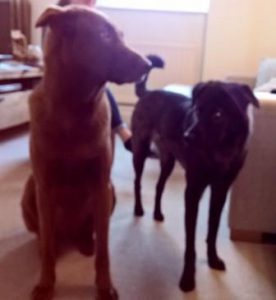The two stunning dogs of mixed breed, Basil and Rosie, recently came back to the UK with the couple who adopted them in Hong Kong where they had been picked up as strays or possibly street dogs. It’s a pity I didn’t get a better photo of them together.
As you can see, although they were now not barking or backing off anymore, both were looking away as I pointed my phone at them which I was trying to do whilst looking the other way.
As I entered the house, the gentleman was trying to corral the dogs down the passageway into the sitting room whilst also trying to keep them quiet – living in a flat they are conscious of their neighbours. I gave my rather large bag to the lady to carry as carrying a bag (like wearing a hat) can contribute to upsetting some dogs.
The barking stopped very quickly as I sat down, but they were both extremely wary. For a short while Basil was ready to bark again at me whilst Rosie backed away. I won them round with food and by making no effort to touch them when they did, soon, come to me.
The owners are particularly concerned because their dogs’ aggressive-sounding barking means that several friends simply won’t visit anymore. There is one close male friend in particular that the dogs don’t like. Apparently he always wears a baseball cap and he’s very tall which apart from the fact that dogs can be more scared of men anyway could perhaps contribute to their unease.
I suggested they had ‘people-food’ ready-prepared, small and tasty bits of food that they only use for when people come to the flat so the only way the dogs get access to this special treat is when people come in or move about.
By trying various different things we worked on a technique whereby I could walk about the room and the dogs would remain relaxed. They can then now do the same things when the friend comes this evening.
This involves, before the person starts to move, one of the owners maintaining their dogs’ attention by calling them over, asking them to sit in front of them and then gently holding onto them whilst feeding them ‘people-food’. By facing their owner the dogs would be turning their backs to the other person. Now the person can move freely about.
I found that once I was up and walking around the room the owner could release the dogs after a second or two and they were fine. This same technique would need to be used for a few seconds each time the person, having been sitting down, moved.
Fortunately these two dogs were not nearly as wary of people in their home as many dogs I go to and this wouldn’t work in more severe cases. It just suited these two. Every case and situation is a bit different.
As always, the guests need training too. They should be asked to move slowly and casually, to give no eye contact to the dogs and when they arrive not to walk too directly or deliberately towards them or the owner. Instead, the owner should turn around and take the dogs with him so that the person follows. Until the dogs get comfortable with someone, they should try not to move too suddenly and to give warning before they stand up. The guest can drop or roll pieces of food.
In a very short while both dogs were actually eating out of my hand.
The barking and anxiety starts with the intercom bell. This is something they can work on easily. Repeatedly one of them can go downstairs and ring the bell while, as soon as the dogs hear it, they get food from the other person. Every time one of the owners either goes out or comes in, they can ring the bell. Because the bell will then only very occasionally mean someone is visiting it will no longer be a trigger, so when a caller is let in the door the dogs aren’t already pre-aroused.
Like everything to do with desensitising and counter-conditioning it takes a lot of repetitions and work. Unless they have a regular run of callers to get the dogs thoroughly at home with people coming and going, it may always need working on to some extent.
Their second issue which I shan’t discuss in much detail now is that Basil, in particular, ignores all calls to come back when he’s on a hunt. The other day he nearly got killed when a chase after a muntjac deer took him across a busy road, followed by Rosie. As a stray who probably had to rely upon hunting for food he will most likely have the chase in his blood.
They have only two safe options really which is hard because dog walks to many people are something where the dogs run free, getting plenty of exercise and doing their own thing. Now they should only ever let Basil off lead in places where there is no escape. If they want him to come back when called, they will need to put in months and months of recall work with Basil. What, after all, is in it for Jack to come back before he’s finished what he is doing? The man’s tone of voice wasn’t such that I, if I were a dog, would find sufficiently inspiring to tempt me to come back! I may not even hear him.
Recall is about much more than just training; it’s also about the dog’s relationship with the person who wants him to come back. To a dog with a high prey drive, it’s quite a challenge for someone to be more relevant, exciting and rewarding than a running muntjac or rabbit!





